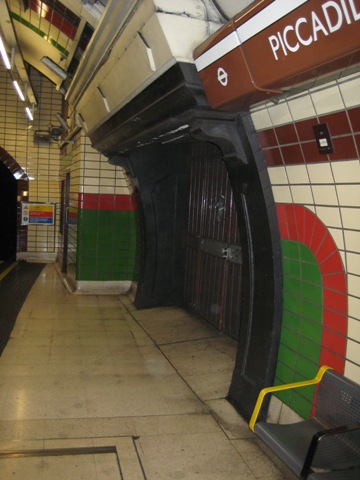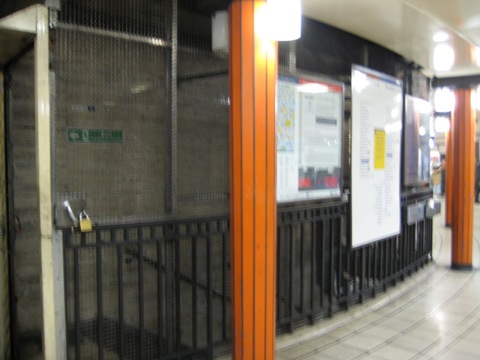
Ever since noticing one evening the ornate disused platform exit on the Bakerloo Line northbound platform, the monkey has had an odd feeling that there was more to this busy station than met the eye.

A few weeks ago a BBC local news report confirmed it as one of their reporters was shown around tunnels long since disused. Thus the monkey was exited to learn that the public could – for a pretty hefty donation to the London Transport Museum charity – undertake the same trip as part of their “Hidden London” programme.
Last Thursday morning saw it line up with 19 other curious folk at the bottom of staircase 4 (you know, where you used to go into the Trocadero), passport (they insist on photo I.D.) and ticket at the ready.

One wristband and a safety lecture later, we gathered around the first of many well-designed printed information boards. A history of the area followed and all was explained.
The first Piccadilly Underground Station was beside the Criterion Theatre, with another exit on the corner of Haymarket and Coventry Street – where that horse fountain sculpture now stands.
It couldn’t cope with demand, so the choice was between putting escalators into the stalls at the Criterion Theatre – which would have improved sightlines for nobody – or building a whole new station.

To avoid disruption, a 5 storey deep spiral staircase was sunk. Then as earth was scooped out, a giant metal roof was put in place, keeping things going on the surface as a whole new station was dug. There’s a board near the photographed staircase entrance now, explaining all.
We headed towards both, another explanatory lecture, and then the thrilling bit started. Descending the spiral staircase – counted in by wristband and protected by two following staff for safety, we first crossed the public tunnels until a door at the end of the platform took us “behind the scenes.”

The first parts of all the tunnels which are visible from platforms are painted black to prevent the public seeing inside. Get beyond that, and the original tiling is visible. The tiler still manufactures for London Transport, most recently on Green Park.

A tribute tile is on one wall of the tunnel system.
Once in the original tunnel network, the London Transport Museum team has installed at various points more signboards detailing the development of the station and its history.

Walking the tunnels we paused at these to hear about the station’s role in World War 2 as a public shelter and storage facility for public artworks. Not always new information, nor delivered with particular flair, it was still amusing to be conducted into the original (gigantic) liftshafts to the strains of “We’re Going To Hang Out The Washing on the Seigfried Line” – a tribute to a station master who was reprimanded for playing it to the huddled and scared masses.
A pause to look at the giant ventilation fan shaft, sadly too dark to photograph but a relief to know we won’t suffocate underground, and a walk past stored railway equipment took us back to the land of the living beyond the bars.

For those seeking an unusual perspective on London, it is a fairly interesting hour or so. The monkey’s personal knowledge of London’s history did have it wishing for a little less chat and a little more time to absorb the atmosphere, but many of the tour group were newcomers to the city and gained a deep understanding of how it came to be.
Those who took the time to put together the display and learn the speech delivered also deserve recognition.
Fairly expensive for what it was, but at least a curiosity was sated. Oh, and for the record, the exit the monkey first photographed was not part of the tour. Apparently, it is one of the original lift shafts but now serves as storage and rest facilities for station staff. So now it knows.
More information on tours, which take place most days at: https://www.ltmuseum.co.uk/hidden-london. The current run is sold out, but more dates will be added. It is worth joining the free mailing list for priority booking.
NOTE: as stopping and flash photography were not possible, the quality of photographs underground is less than the monkey hoped – but it wanted to share them anyway.

